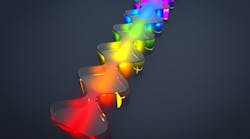Airy beams make stronger terahertz waves for improved standoff detection
Researchers at the University of Rochester (Rochester, NY) have created a terahertz wave that is more than five times stronger than what is generated by more conventional means, leading them to believe that a terahertz wave—and the image of a hidden object—can be detected at much greater distances (up to 100 feet) in the future.
Related Article
The research, published in Optica, was led by Kang Liu, a PhD student in optics, and Xi-Cheng Zhang, the M. Parker Givens Professor of Optics and the director of the Institute of Optics, in collaboration with a group from Greece led by Tzortzakis Stelios.
Terahertz waves, which fall between microwave and the infrared band on the electromagnetic spectrum, can penetrate certain solid objects that are opaque to visible light to create images of what is hidden from view. Unlike traditional x-rays, the waves do so without damaging human tissue. All that makes terahertz technology a promising tool for Homeland Security and other law-enforcement agencies. But before terahertz can be widely used, a number of obstacles need to be overcome, including how to make them more effective over greater distances.
One of the drawbacks is that the waves are absorbed by water molecules in the air and weaken significantly over longer distances, making them generally ineffective. One solution is to generate the waves near the target, so that they have only a short distance to travel. It's also important that the waves are intensive, because, as Liu points out, "The stronger the terahertz wave, the more work it can do."
The key to their results was the use of a specific exotic laser beam—called a ring-Airy beam—to generate a terahertz wave that has 5.3 times the pulse energy of waves created with standard Gaussian beams. Ordinary beams of light spread out as they travel, but that’s not the case with ring-Airy beams, which curve toward the center from all points.
To begin the process, Liu directed a laser beam onto a spatial light modulator (SLM), which formed the ring-Airy beam. As the name indicates, the beam is circular with a hollow center. Instead of spreading out as it travels, the beam collapsed inward, creating an intensely excited region of free electrons called a plasma. Those electrons, in turn, generated the terahertz wave, which would be capable of penetrating a nearby target and reflecting images or providing vital chemical information about what is hidden.
"When the target is a suspected explosive device, it's important to get the work done at a safe distance," said Liu. "We believe our method could help THz remote sensing from more than 100 feet away by providing a more robust and flexible way to generate THz remotely."
The modulator allowed the researchers to change the size of the ring-Airy beam and fine-tune the dimensions of the plasma that is created. The next step, as Liu sees it, is to manipulate ring-Airy beams to create stronger terahertz waves over greater distances.
SOURCE: University of Rochester; http://www.rochester.edu/newscenter/from-unconventional-laser-beams-to-a-more-robust-imaging-wave/

Gail Overton | Senior Editor (2004-2020)
Gail has more than 30 years of engineering, marketing, product management, and editorial experience in the photonics and optical communications industry. Before joining the staff at Laser Focus World in 2004, she held many product management and product marketing roles in the fiber-optics industry, most notably at Hughes (El Segundo, CA), GTE Labs (Waltham, MA), Corning (Corning, NY), Photon Kinetics (Beaverton, OR), and Newport Corporation (Irvine, CA). During her marketing career, Gail published articles in WDM Solutions and Sensors magazine and traveled internationally to conduct product and sales training. Gail received her BS degree in physics, with an emphasis in optics, from San Diego State University in San Diego, CA in May 1986.


